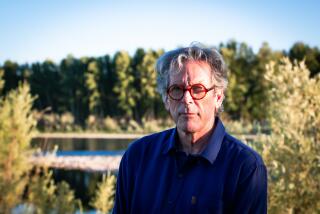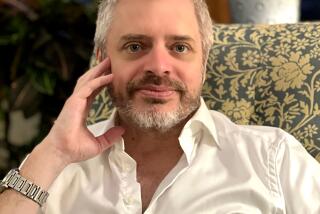An Unsentimental W.H. Auden : NONFICTION : AUDEN,<i> By Richard Davenport-Hines (Pantheon: $30; 416 pp.)</i>
- Share via
‘A shilling life will give you all the facts,” wrote the poet W.H. Auden in “Who’s Who,” a 1934 poem skeptical of biography. Yet “facts” may lead to puzzling contradictions. Best leave the lives of great writers alone, stick with their work--that’s the implication. But in private, Auden loved to speculate. “I don’t think Browning was very good in bed,” he is said to have remarked of the 19th century poet.
Readers of “Auden,” a new biography by Richard Davenport-Hines, might keep these contradictory messages in mind while digesting the assorted ingredients of this densely textured book.
Part “shilling life,” part literary analysis, part psychological study, the first biography of Wystan Hugh Auden in more than 10 years lays out the familiar elements of the great poet’s life, while attempting a new synthesis of the facts. It’s no easy task, given his eternally shifting allegiances. These included a brush with fascism and then with left-wing causes; his long lasting fascination with psychology; and finally his return to the Christianity of his childhood. Even to assess Auden’s work means stumbling over controversy. Following his first decade of fame, Auden puzzled admirers by shifting from high-toned symbolism to earthier poems (often rhyming) that mixed lyric intensity with comedy, even vulgarity. And he went on to renounce as falsely rhetorical his so-called “political” poems of the 1930s, substantially revising them for later anthologies. A further complicating factor is that the many references to his homosexuality in his early work are disguised, thus provoking a multitude of differing interpretations.
As for his life, this is a portrait of an upper-middle-class Englishman who in 1939 left his hidebound native country for the United States because he believed he might be more himself here. But how? Again, there are contradictions. He was apparently a kind man, with many friends, but he could also be unkind. From a mix of misogyny and a dislike of confessional poetry, he heckled Anne Sexton from the stage at the 1967 Poetry International festival in London, reducing her to tears. His defense: She “read an acutely embarrassing poem about her attempted suicide and losing her baby.”
As punctilious as any office worker in his daily routine, Auden was also untidy, hard-drinking and long addicted to Benzedrine. By his 50s, he was already old, as the book’s heart-rending photos bear witness. With his skin thickened and creased by disease (Touraine-Solente-Gole syndrome, the author says), he looked, to quote his friend, political theorist Hannah Arendt, “as if life itself had delineated a kind of face-scape to make manifest the ‘heart’s invisible furies.’ ” Of these, perhaps the most dissonant was his lifelong relationship with poet librettist Chester Kallman, with whom he collaborated on many operatic projects. It was a relationship characterized not only by Auden’s tolerance of Kallman’s promiscuity--and Kallman’s need for long separations in order to be someone other than the famous poet’s lover--but also by profound mutual affection, understanding and need. When Auden died in 1973, Kallman drank himself to death 15 months later.
Plenty of facts here, plenty of drama. But addicts of celebrity lives, used to a quick jog through freshly exhumed salaciousness, will be disappointed. Aside from one short-lived heterosexual affair, Auden was always open about and in harmony with his gayness, though it was of necessity coded in most of his work, since homosexuality was illegal in England until 1967. Of the major events of Auden’s life, Davenport-Hines has little new to say. Nor does he care. His interest lies not in rehashing details but in finding hidden patterns within the contradictory material. Indeed, his narrative is so in thrall to his net of interlocking themes that any given paragraph, nipping back and forth in time, packed with literary allusions and commentary from the (admittedly) highly quotable cast of thousands who knew Auden well, will slow even the most dedicated gossip-hunter to a somnambulant crawl.
This approach puts “Auden” on a different plane from the other major Auden biographies: Humphrey Carpenter’s meticulous “W.H. Auden, a Biography” and the passionate scholarship of “Early Auden” by Auden’s executor, Edward Mendelson--both published in 1981--with which, the author says, he isn’t competing. “Auden” is also quite unlike various memoirs of the poet by friends: Charles Osborne, whose 1979 book (“W.H. Auden: The Life of a Poet”) has just been reissued in paperback, Alan Ansen, Charles H. Miller and Thekla Clark--all of them warm, anecdotal and filled with pithy Auden aphorisms.
Davenport-Hines doesn’t dismiss the witty Auden. Humor, he notes, is one of Auden’s most powerful poetic tools. But his goal is to uncover the poet of integrity, the serious, unsentimental Auden, who fought a lifelong battle against received wisdom and easy truths--the Auden who is still read. (It was his “Funeral Blues” that was recited in the film “Four Weddings and a Funeral.”)
Sometimes knotty, always thoughtful, Davenport-Hines weirdly mirrors Auden’s struggle with ideas of wholeness and fragmentation. For Auden wrote in part to distance himself from chaos of all sorts. His search for meaning took him through various ideologies such as psychology (his doctor father’s passion), the 1930s leftist political dogma that seduced so many of his friends and fellow writers, and, in the 1940s, Christianity, an odd allegiance perhaps, given his adult scepticism of all systems.
Yet Davenport-Hines does a good job of showing that Auden’s shifting loyalties were not facile but the product of a brilliant intellect groping for something that felt true. In Christianity finally was a system in which all the puzzling contradictions of his life, good and evil, beauty and imperfection, could be reconciled. Christianity made sense of Auden’s lifelong feelings of isolation, his pleasure in the natural or inanimate world and his yearning for the unattainable. It also allowed him to believe in the positive nature of suffering, to find joy even in his anguish over Kallman’s disloyalty. This element of masochism is to be found time and again in Auden’s work. Hard as he may have been on others, the author suggests, Auden was hardest on himself.
Davenport-Hines presents such observations as all-encompassing truths. They are not. Occasionally, as in his spirited defense of Auden against numerous critics (who still argue hotly over which period of Auden’s poetry is best), there is even a touch of imbalance: “It is too easy to forget the noxious, pompous stupidity that leaked over their epoch [the 1930s] like gas fumes from a defective stove.” Fun, but one misses the unvarnished, often quite illuminating “facts” of earlier biographies.
Still, the author’s passion for his subject makes for oddly gripping reading. And though only a partial picture of Auden emerges, this biography gives us many moving glimpses into the workings of a fine poet’s mind.
More to Read
Sign up for our Book Club newsletter
Get the latest news, events and more from the Los Angeles Times Book Club, and help us get L.A. reading and talking.
You may occasionally receive promotional content from the Los Angeles Times.







